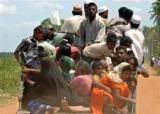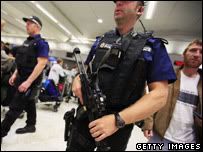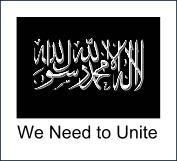Bismillahi rahmani raheem

In August (2006) more than
40,000 Muslim civilians fled in fear from their hometown Muttur in eastern Sri Lanka, as violence erupted between Government forces and Tamil Tiger rebels over a neighbouring water sluice. About 100 civilians were also believed to be killed or missing from this clash. This is only one major incident in the sufferings Sri Lankan Muslims continue to undergo for more than 25 years.
Sri Lanka and MuslimsSri Lanka is an island nation of 20 million people and it is located in the Indian ocean, just off the southern tip of India. It is home to Sinhala, Tamil and Muslim ethnic communities who have lived in harmony with each other for centuries. The Sinhalese form the majority (74%) of the population followed by Tamils (15%) and Muslims (9%).

Sri Lanka’s 1.5 million Muslims are mostly Moors (i.e. descendent's of Arab traders who settled in the island centuries ago) while about 1/10 of them are Malays (who came to Sri Lanka during Dutch & British colonial rule.) These Muslims have over the time developed their own Sri Lankan identity and live scattered throughout the country in small communities. In the present context it's also noteworthy Muslims form the single largest ethnic community in the eastern province.
The Separatist WarIn early 1980s the rebel group called LTTE (Liberation Tigers of Tamil Eelam) or better known as Tamil Tiger, launched a violent separatist struggle for a separate Tamil state in the Tamil majority north-eastern provinces of the country claiming the Tamil people were oppressed by the majority Sinhala Government. The war that ensued has so far claimed more than 60,000 lives and has devastated the country and its people.
Tamil Tigers and Muslims
From the beginning of the separatist war Tamil Tigers claimed to represent and fight for what they claimed as the "oppressed" Tamil minority of Sri Lanka. In addition the Tamil Tiger rebels made a preposterous claim that Muslims were not a separate ethnic community or a minority but part of Sri Lanka’s Tamil ethnicity. This they made realizing the strategic importance of numbers in their struggle for a separate Tamil country and due to the considerable concentration of Muslims in north-eastern provinces.
But the Sri Lankan Muslims with their own ethnic, cultural and religious identity opposed the Tamil Tigers preposterous claim. And also having lived in harmony for centuries among the Sinhala majority and used to considering Sri Lanka as their motherland the Muslims vehemently opposed the Tiger rebels struggle for a separate country.
Violence against MuslimsAll Sri Lankan ethnic communities have suffered from the war but the islands third, and smallest, ethnic community –the Sri Lankan Muslims have become the worst affected and forgotten losers in this vicious struggle.

Since the start of the separatist war Tamil Tigers planed and carried out ruthless attacks against the Muslims living in the north-eastern areas of the country including ethnic cleansing, mass killings, forcefully taking over Muslim properties, imposing various taxes, abducting Muslim youth as Tiger guerrilla cadres and others for ransom.
1990-1991 was a particularly terrible period for Muslims. In October 1990 the Tamil Tigers ordered all Muslims living in Tiger controlled northern Jaffna peninsula to leave within 48 hours or face execution. So nearly 90,000 Jaffna Muslims fled from their homes overnight. Each fleeing person was only allowed to take 300 rupees in cash (around 10 US $ then) and a few cloths and leave behind everything else they had, which subsequently the Tamil Tigers took over. These Muslims fleeing the northern peninsula were gathered in refugee camps in Putlam and Kalpity areas. These Muslim people had lived better lives in Jaffna while some had even been very successful businessmen. Even today after 15 years, around 53,000 of them still live in these refugee camps.
The same year Tamil Tigers
massacred 172 Muslims praying in a Mosque in the eastern town of Kathankudy. Not stopping from these, they have since then killed many thousands of north-eastern Muslims by sporadic attacks, not to mention they have taken over Muslim peoples properties in Eastern areas under their control. So the mainly agrarian North-Eastern Muslims have been continuously suffering in the hands of the ruthless Tamil Tigers.
Current Situation of Muslims
The successive governments elected to power have not addressed the concerns and sufferings of Muslims. Furthermore on many occasions the protection offered by Government forces to the Muslims has been inadequate, thus exposing them to the ruthless Tamil Tiger terrorism. Meanwhile the Government, Muslims and Sinhalese from other parts of the country, Islamic organizations and other NGOs, continue aid and rehabilitation efforts. However the relief and rehabilitation efforts are insufficient and with the continuation of hostilities despite a ceasefire since 2002, Muslims in war-torn areas continue to endure the adversities of war.

Meanwhile Muslim political parties and representatives are stuck in personal wrangling and are divided. Many Muslim politicians are trying to make the pains and sufferings of these destitute people into their own personal projects to uplift their political image. This was evident from the recent Muttur incident where currently 40,000 Muslims are displaced and continue to live in refugee camps undergoing much hardship. Consequently there is no one to speak for the real concerns and sufferings of the Muslims.
Caught in this intricate and seemingly endless web of violence between Tamil Tiger terrorists and the Government, Sri Lanka's Muslims are increasingly desperate, unsure which way to turn, and whom to trust. Forgotten victims of a particularly vicious war, they are trapped between hammer and anvil.
Related Useful Links:Labels: Buddhist, Hindu, LTTE, Malays, Minority, Moors, Muslims, Sinhala, South Asia, Sri Lanka, Tamil Tigers, Tamils, Terrorism, War

 In August (2006) more than
In August (2006) more than  Sri Lanka’s 1.5 million Muslims are mostly Moors (i.e. descendent's of Arab traders who settled in the island centuries ago) while about 1/10 of them are Malays (who came to Sri Lanka during Dutch & British colonial rule.) These Muslims have over the time developed their own Sri Lankan identity and live scattered throughout the country in small communities. In the present context it's also noteworthy Muslims form the single largest ethnic community in the eastern province.
Sri Lanka’s 1.5 million Muslims are mostly Moors (i.e. descendent's of Arab traders who settled in the island centuries ago) while about 1/10 of them are Malays (who came to Sri Lanka during Dutch & British colonial rule.) These Muslims have over the time developed their own Sri Lankan identity and live scattered throughout the country in small communities. In the present context it's also noteworthy Muslims form the single largest ethnic community in the eastern province. From the beginning of the separatist war Tamil Tigers claimed to represent and fight for what they claimed as the "oppressed" Tamil minority of Sri Lanka. In addition the Tamil Tiger rebels made a preposterous claim that Muslims were not a separate ethnic community or a minority but part of Sri Lanka’s Tamil ethnicity. This they made realizing the strategic importance of numbers in their struggle for a separate Tamil country and due to the considerable concentration of Muslims in north-eastern provinces.
From the beginning of the separatist war Tamil Tigers claimed to represent and fight for what they claimed as the "oppressed" Tamil minority of Sri Lanka. In addition the Tamil Tiger rebels made a preposterous claim that Muslims were not a separate ethnic community or a minority but part of Sri Lanka’s Tamil ethnicity. This they made realizing the strategic importance of numbers in their struggle for a separate Tamil country and due to the considerable concentration of Muslims in north-eastern provinces. Since the start of the separatist war Tamil Tigers planed and carried out ruthless attacks against the Muslims living in the north-eastern areas of the country including ethnic cleansing, mass killings, forcefully taking over Muslim properties, imposing various taxes, abducting Muslim youth as Tiger guerrilla cadres and others for ransom.
Since the start of the separatist war Tamil Tigers planed and carried out ruthless attacks against the Muslims living in the north-eastern areas of the country including ethnic cleansing, mass killings, forcefully taking over Muslim properties, imposing various taxes, abducting Muslim youth as Tiger guerrilla cadres and others for ransom. The successive governments elected to power have not addressed the concerns and sufferings of Muslims. Furthermore on many occasions the protection offered by Government forces to the Muslims has been inadequate, thus exposing them to the ruthless Tamil Tiger terrorism. Meanwhile the Government, Muslims and Sinhalese from other parts of the country, Islamic organizations and other NGOs, continue aid and rehabilitation efforts. However the relief and rehabilitation efforts are insufficient and with the continuation of hostilities despite a ceasefire since 2002, Muslims in war-torn areas continue to endure the adversities of war.
The successive governments elected to power have not addressed the concerns and sufferings of Muslims. Furthermore on many occasions the protection offered by Government forces to the Muslims has been inadequate, thus exposing them to the ruthless Tamil Tiger terrorism. Meanwhile the Government, Muslims and Sinhalese from other parts of the country, Islamic organizations and other NGOs, continue aid and rehabilitation efforts. However the relief and rehabilitation efforts are insufficient and with the continuation of hostilities despite a ceasefire since 2002, Muslims in war-torn areas continue to endure the adversities of war. Meanwhile Muslim political parties and representatives are stuck in personal wrangling and are divided. Many Muslim politicians are trying to make the pains and sufferings of these destitute people into their own personal projects to uplift their political image. This was evident from the recent Muttur incident where currently 40,000 Muslims are displaced and continue to live in refugee camps undergoing much hardship. Consequently there is no one to speak for the real concerns and sufferings of the Muslims.
Meanwhile Muslim political parties and representatives are stuck in personal wrangling and are divided. Many Muslim politicians are trying to make the pains and sufferings of these destitute people into their own personal projects to uplift their political image. This was evident from the recent Muttur incident where currently 40,000 Muslims are displaced and continue to live in refugee camps undergoing much hardship. Consequently there is no one to speak for the real concerns and sufferings of the Muslims. For the past two week the corporate media has been bursting with news on the alleged plot to blow U.S. jetliners out of the Atlantic skies. It resulted in causing great amount of panic and rekindle fear of “Islamic terror” in the minds of people. A Sri Lankan newspaper columnist made these observations about media latest spotlight.
For the past two week the corporate media has been bursting with news on the alleged plot to blow U.S. jetliners out of the Atlantic skies. It resulted in causing great amount of panic and rekindle fear of “Islamic terror” in the minds of people. A Sri Lankan newspaper columnist made these observations about media latest spotlight. August 10, British police revealed the alleged plot to blow up about 10 civilians jetliners over the Atlantic using disguised liquid explosives. So far media reports claim British and Pakistani authorities have arrested 41 people in the two countries in connection with the suicidal plan.
August 10, British police revealed the alleged plot to blow up about 10 civilians jetliners over the Atlantic using disguised liquid explosives. So far media reports claim British and Pakistani authorities have arrested 41 people in the two countries in connection with the suicidal plan.
 It is very encouraging to see many scholars, leaders, intellectuals and journalist increasingly emphasizing the need for Muslim unity, in this long due awakening of the Muslim Ummah. But the effort of these people alone is not sufficient to unite the Ummah. We the Muslim masses must share this responsibility and play our part towards uniting Muslims. It is high time we put this among our priorities in our daily life. Allah says in the Qur’an "Verily Allah will not change the condition of people until they change it themselves." [13:11]
It is very encouraging to see many scholars, leaders, intellectuals and journalist increasingly emphasizing the need for Muslim unity, in this long due awakening of the Muslim Ummah. But the effort of these people alone is not sufficient to unite the Ummah. We the Muslim masses must share this responsibility and play our part towards uniting Muslims. It is high time we put this among our priorities in our daily life. Allah says in the Qur’an "Verily Allah will not change the condition of people until they change it themselves." [13:11] On the subject of Muslims future, Dr. Rashid Shaz of New Delhi, author of ‘Understanding the Muslim Malaise’ and ‘Islam: Negotiating the future’, has been at the forefront for a regeneration in Islamic thought among Indian Muslims. After the demolition of Babri Masjid in 1993, he launched an international weekly magazine, the Milli Times. Presently he is chairman of Peace India International and edits a bi-monthly journal on Future Islam in Arabic, English and Urdu.
On the subject of Muslims future, Dr. Rashid Shaz of New Delhi, author of ‘Understanding the Muslim Malaise’ and ‘Islam: Negotiating the future’, has been at the forefront for a regeneration in Islamic thought among Indian Muslims. After the demolition of Babri Masjid in 1993, he launched an international weekly magazine, the Milli Times. Presently he is chairman of Peace India International and edits a bi-monthly journal on Future Islam in Arabic, English and Urdu. 

 At last I decided to write a blog. So here it is -the Unite Muslims blog, my first blog. Writing a blog as a step towards uniting Muslims has been at the back of my mind for several months. Unfortunately it wasn’t till today I finally decided to cut the Gordian knot. I am not much of a writer but I think I'll be able to develop my writing skills in the process and voice my convictions more clearly. Inshaallah this is going to be a new experience to me. Well, first things first. Why did I start this blog? What are my objectives?
At last I decided to write a blog. So here it is -the Unite Muslims blog, my first blog. Writing a blog as a step towards uniting Muslims has been at the back of my mind for several months. Unfortunately it wasn’t till today I finally decided to cut the Gordian knot. I am not much of a writer but I think I'll be able to develop my writing skills in the process and voice my convictions more clearly. Inshaallah this is going to be a new experience to me. Well, first things first. Why did I start this blog? What are my objectives?



